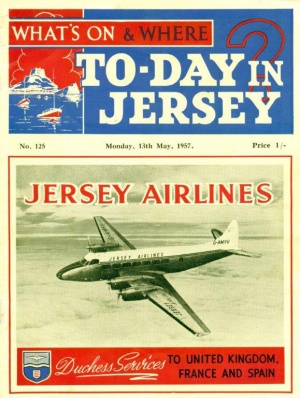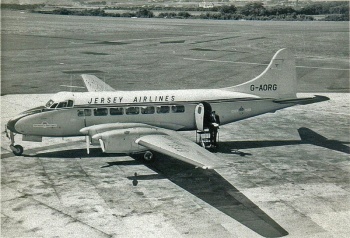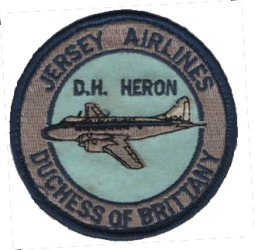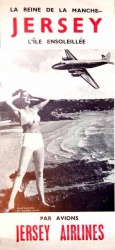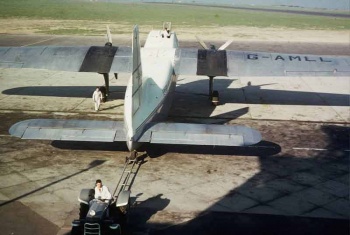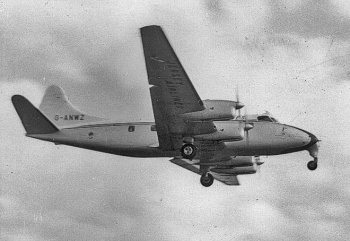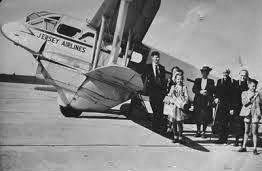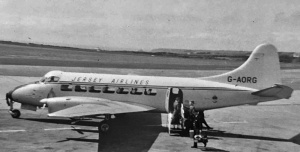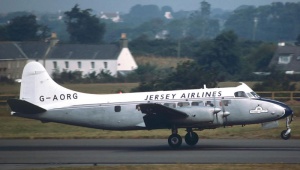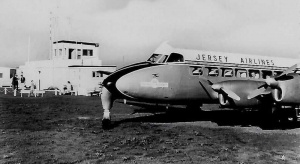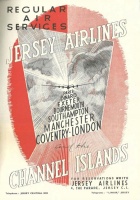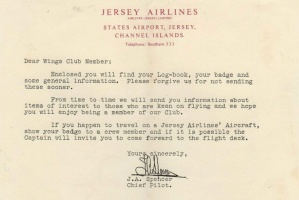Trips to France
During the summer of 1948 Maldwyn Thomas was working with a hire car company in St Helier. He was continually asked by his customers how they could get to nearby France and so he chartered a variety of aircraft from Croydon to take tourists on day trips to Dinard in Brittany. These trips became so popular that he decided to form a company and make the charters available on a longer term basis.
Airlines (Jersey) Limited was formed in November 1948, with the express purpose of operating aircraft for tourist traffic. Thomas had tried to name the company Jersey Airlines Ltd, but the similarity to Jersey Airways Ltd, the first local airline, recently absorbed into British European Airways, ruled that out. He had to settle for registering Jersey Airlines as a trading name.
The following year he chartered an ancient DH 89A Rapide G-AGLP from Barclays International Airways at Croydon for the Easter period, taking on its pilot, Bernard Gardiner, who was to be chief pilot of Jersey Airlines throughout its existence.
Early flights were mainly day trips to Dinard or St Brieuc, but soon Guernsey, Alderney and Paris (Toussus le Noble) were added to the list of destinations, along with one-off charters to places such as Clermont Ferrand, to pick up a family injured in a car crash. In its early years Jersey Airlines was also involved if flying deceased people to Guernsey for cremation, because that island had a crematorium before Jersey.
Two reconditioned Rapides were purchased in 1949 and 1950 and pilot Alan Spencer joined to fly the second, remaining with the airline alongside Bernard Gardiner until it was purchased by the parent company of British United Airways in 1963.
BEA partnership
In 1951 Maldwyn Thomas took Jersey Airlines into partnership with British European Airways under an associate company scheme which involved BEA taking a stake in the airline, which was then able to compete on BEA routes. Thomas applied for all BEA's routes. He didn't get them, but he did start a Jersey-Exeter service, followed by Jersey to Paris - Orly, and then Le Bourget. By the early 1960s Dakotas and Hart Heralds were being operated to Amsterdam.
BEA had lost the monopoly given it by the Labour administration in 1947 and Jersey Airlines bought back their 25 per cent holding, giving them more freedom to compete. But soon came another change of direction, with the partnership with British United Airways in 1962. This was supposed to retain Jersey Airlines' identity while bringing increased business, but it didn't work and Thomas soon pulled out, allowing his airline to become submerged by the larger organisation.
By the mid-50s Jersey Airlines were operating scheduled services to Gatwick, Southampton, Exeter, Bournemouth, Brittany, Paris and Guernsey and Alderney. When Gatwick closed for two years for redevelopment, they switched their London operations to Croydon, but operated the first scheduled service into Gatwick when the airport reopened.
Wikipedia history
Jersey Airlines was a private British airline formed in 1948. In 1952 the airline operated its first scheduled service. Four years later, British European Airways (BEA) took a 25% minority stake and made it an "associate".
- In June 1958 a Jersey Airlines de Havilland Heron became the first commercial airliner to arrive at the newly reconstructed Gatwick Airport.
- In 1960 Jersey Airlines ordered four state-of-the-art Handley Page Dart Herald 200 series turboprops.
- By 1962 BEA had sold its 25% minority holding in Jersey Airlines. The same year, Jersey Airlines became part of the British United Airways (BUA) group of companies.
- In August 1963 Jersey Airlines changed its trading name to British United (CI) Airways.
During the summer of 1948 Welshman Maldwyn Thomas was working for a car rental company in St Helier and arranged ad hoc charters for day trippers to be flown from London's Croydon Airport to Dinard in Brittany, France. Due to the growing popularity of these trips, in November of that year, he decided to form a company to offer such charter flights on a regular basis. That company was to be incorporated under the name Jersey Airlines Limited. However, its similarity to an existing company named Jersey Airways Limited, a recently nationalised airline that was absorbed into BEA, resulted in the new company being registered as Airlines (Jersey) Limited and using Jersey Airlines as its trading name.
Scheduled services
In 1952 Jersey Airlines entered the scheduled service market. All scheduled services were marketed as Duchess Services. To aid the development of its scheduled route network, the airline concluded an "association" agreement with BEA. This also resulted in BEA acquiring a 25% minority shareholding in Jersey Airlines in 1956 and entailed the transfer of BEA's Southampton—Guernsey and Southampton—Alderney routes. By winter 1956 Jersey Airlines' scheduled route network included Croydon, Bournemouth, Exeter, Manchester, and Southampton in England, Alderney, Guernsey and Jersey from the Channel Islands, as well as Cherbourg, Dinard, Nantes, Saint-Brieuc and Paris Orly in France, and Bilbao in Spain.
By May 1958 Jersey Airlines moved its main UK mainland operating base from Croydon to Gatwick. One of the airline's de Havilland Herons operated the first scheduled flight to arrive at the newly reconstructed airport.
At the 1960 Farnborough Airshow Jersey Airlines placed an order for four 50-seat Handley Page Dart Herald 200 turboprop airliners for delivery the following year. When Mr Thomas, the airline's chairman and managing director, signed the contract later that year, the number of aircraft on firm order was increased to six series 200 Dart Heralds. The first two were to be delivered in 1961, a further two in 1962 and the final two in 1963. Unforeseen design and production problems delayed the delivery of the first batch until summer 1962. To enable Jersey Airlines to introduce the Dart Herald into commercial service at the start of the 1962 summer timetable as planned, Handley Page supplied three interim aircraft - two smaller 44-seat Herald 100s as well as one 50-seat Herald 200.
One of the two 100 series aircraft was the Herald's prototype/demonstrator and the other was the first production aircraft to be delivered to BEA. The first of Jersey Airlines' own aircraft sporting the airline's blue and gold livery, including the civil air ensign on the tail, was finally handed over to the airline in January 1963. Another three aircraft were delivered later the same year, resulting in most scheduled routes being served with the new turboprop type. Jersey Airlines marketed its new turboprops as Herald Class. The older DC-3 and Heron piston airliners were marketed as Dakmaster Class and Duchess Class respectively.
The seasonal nature of Jersey Airlines' scheduled operation compelled it to charter Heralds to Lord Brothers, a contemporary package tour operator, as the summer season drew to a close. These planes flew British holidaymakers as far afield as Spain, Morocco, the Canary Islands as well as Athens and the Greek islands.
BEA quits
In 1961 Jersey Airlines carried 310,000 scheduled passengers. The same year BEA terminated its association agreement with Jersey Airlines as both airlines had become competitors on London—Jersey and London—Guernsey, the most important routes in the London – Channel Islands market.
The BUA group's takeover of Jersey Airlines in May 1962 followed BEA's disposal of its minority holding in its former regional "associate" on 31 March of that year.Together with the earlier acquisition of the British Aviation Services group, the Jersey Airlines takeover expanded the BUA group fleet to more than 100 aircraft and increased its payroll to 6,000. It also made BUA bigger than British Overseas Airways Corporation (BOAC) in terms of scheduled passengers carried. By that year's summer, Plymouth, Coventry, Glasgow and Belfast were added to the scheduled route network in the UK, and Amsterdam Schiphol, Nice, Quimper, Dublin and Cork joined the international scheduled route network.
On 1 August 1963 Airlines (Jersey) Ltd dropped the Jersey Airlines trading name in favour of British United (CI) Airways and became a wholly owned subsidiary of Air Holdings, the holding company set up by the group's shareholders in November 1961 to facilitate the creation of a large private sector airline through additional acquisitions of rival independent airlines.
The 1967-68 reorganisation of the BUA group's regional activities resulted in the amalgamation of BUA (CI), British United (Manx) Airways and Morton Air Services under the BUIA name. The new entity began trading on 1 November 1968.
- Jersey Airlines acquire an expensive De Havilland Heron - ''Flight'' report
- Proving flight to Alderney for the Handley Page Herald

